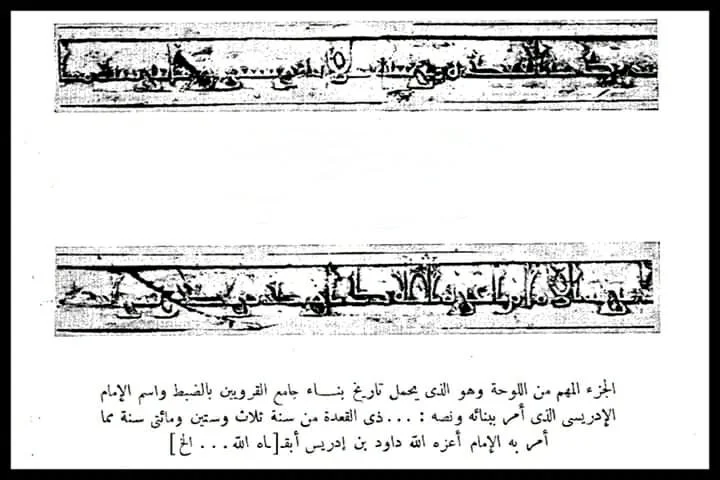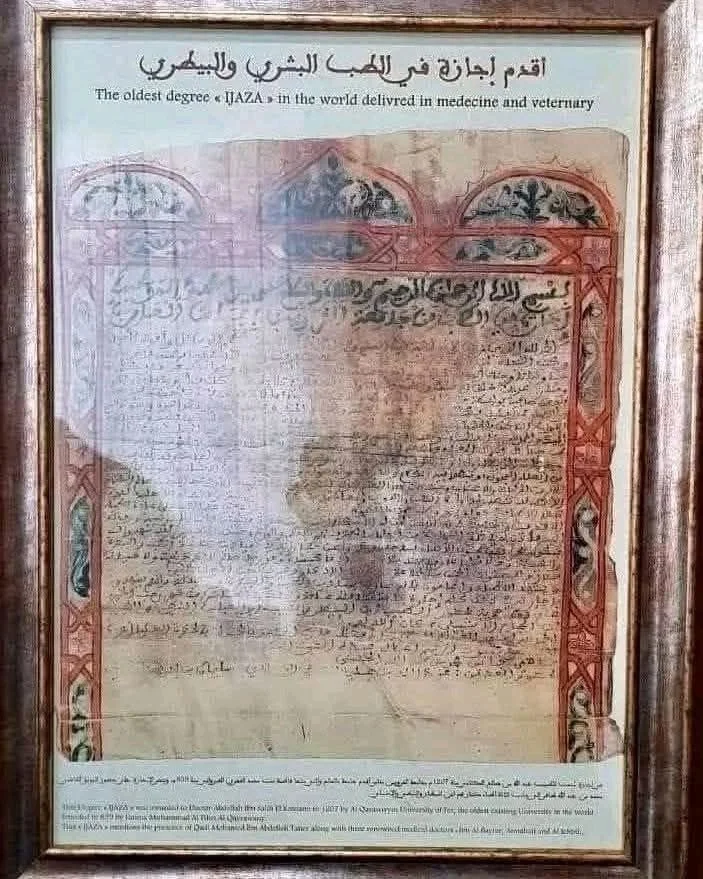Al-Qarawiyyin The Oldest University in the World – A Moroccan Legacy in the Heart of Fez
The University of Al-Qarawiyyin, also known as “Al Quaraouiyine” or “Al-Karaouine,” is considered one of the oldest continuously operating educational institutions in the world to this day. While many people attribute the founding of the university to Fatima al-Fihri, this belief remained until researchers discovered a plaque above the mihrab (prayer niche), revealing the true founder and builder of the university: Dawud ibn Idris, the son of Idris II, around 857–859 CE ( ” according to the plaque the construction date is 877 AD”), in the old medina of Fez, Morocco. This edifice was not merely a place of worship—it became a beacon of knowledge and scholarship, attracting diverse sciences and producing renowned scholars whose fame extended beyond the Islamic East.

“…Dhu al-Qa’dah of the year 263 AH, by order of the Imam—may God honor him—Dawud ibn Idris—may God preserve him…”
- This translates the essential part of the inscription, which specifies:
- Exact date: Dhu al-Qa’dah 263 AH (corresponding to August/September 877 CE).
- Commander: Imam Dawud ibn Idris, who is mentioned as the one who ordered the construction.
- Honorifics: Traditional phrases used in Islamic epigraphy like “may God honor/preserve him”.
The Religious and Educational Foundation of Al Quaraouiyine
The University of Al-Qarawiyyin began as a mosque and gradually evolved into a religious school (madrasa), where Islamic jurisprudence, languages, and natural sciences were taught.
Development Through the Ages al-quaraouiyine
The University of Al Quaraouiyine underwent significant expansions during the rule of the Idrisid, Almoravid, and Marinid dynasties. It eventually became an international center for knowledge and research, influencing parts of the Islamic West and even Europe.
Notable Scholars and Alumni of Al Quaraouiyine
Al Quaraouiyine has left a profound impact on global thought through its distinguished scholars and graduates, including:
Ibn Khaldun: Founder of sociology and author of The Muqaddimah.
Ibn Rushd (Averroes): Philosopher who introduced Aristotelian thought to the West.
Ibn Bajjah (Avempace): Andalusian philosopher and physician.
Ibn al-Azraq: Renowned for his world maps and founder of the science of geography publications.
Maimonides: Famous Jewish philosopher and physician.
Pope Sylvester II: A prominent visitor and scholar linked to Fez.
Leo Africanus: Renowned 16th-century geographer.
Curriculum at the University of Al-Qarawiyyin
The University of Al-Qarawiyyin, particularly in its classical stages during the Middle Ages, had a rich and multidisciplinary curriculum that combined religious and linguistic sciences with rational and natural sciences. Below are the main subjects that were taught:
1- Religious and Islamic Sciences
Islamic jurisprudence (especially the Maliki school).
Principles of jurisprudence and methods of deduction.
Hadith sciences (narration and authentication).
Qur’anic sciences (exegesis, readings).
Islamic creed (theology).
2- Language and Literature
Grammar and morphology.
Rhetoric and eloquence.
Arabic poetry and literature.
Arabic calligraphy.
3- Rational and Philosophical Sciences
Logic.
Philosophy (especially translated Greek philosophy).
Science of debate and disputation.
4- Natural and Mathematical Sciences
Mathematics (algebra, arithmetic).
Geometry.
Astronomy and timekeeping.
Medicine and pharmacy.
Physics (known at the time as “natural sciences”).
5- Other Sciences
History and biographies.
Geography and cartography.
Theoretical music (sometimes included under philosophy).
The educational system at Al-Qarawiyyin relied on memorization, comprehension, and discussion. The ijazah (graduation certificate) was granted only after the student successfully completed a set of texts and subjects before a panel of scholars.

Al-Qarawiyyin University remains a living symbol of deep-rooted scholarly traditions in Morocco and an example of how educational institutions can adapt to changing eras without losing their identity. It is not merely an academic institution but a cultural and civilizational heritage that has contributed to shaping human thought. It serves as a continuous source of knowledge and science, linking the past with the present and envisioning the horizons of the future.